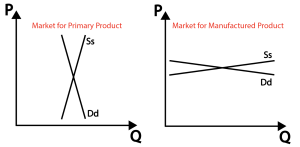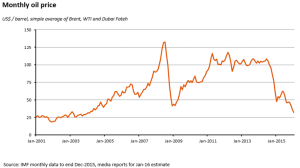Most of us are familiar with essay questions in the “A” level exams that discuss about Price Elasticity concepts. The most common question, and one that students should be familiar with, goes along the lines of “Discuss how the concepts of price elasticities help business owners make appropriate business decisions.”.
However, the concept of Price Elasticity can be utilised to explain other observations as well. In today’s example, I will show how it can explain why countries that diversify their exports away from Primary Products tend to do better than if they hadn’t.
What are Primary Products and Secondary Products?
Primary products refer to “goods that are available from cultivating raw materials without a manufacturing process“. Examples of primary products are agricultural products, oil, metals and wood.
Secondary products on the other hand, refer to “manufactured” products. These are “final” products that have undergone the manufacturing process to be transformed from combinations of raw materials, into products that are ready for final consumption.
Examples of manufactured products include handphones, aeroplanes and televisions.
Primary Products tend to have a price inelastic demand and supply
The supply of primary products tends to be price inelastic – which means that suppliers can be expected to increase/decrease their quantity supplied less than proportionately given an increase/decrease in the price of the primary product.
This is because:
- In the case of mining minerals and metals, increasing the scale of mining operations is usually achieved by opening new mines (which requires lengthy prospecting and thereafter, setting up the required infrastructure). At the same time, increasing the rate of production from existing mines can be achieved only up to an extent.
- In many cases, raw materials are often considered to be non-renewable and finite (e.g. metals, minerals, oil)
- In the case of agricultural products, crops take time to grow, and are often seasonal, which greatly reduces supply flexibilities.
- Also, most agricultural produces are perishable, which means that they need to be consumed within a relatively short time period.
Likewise, the demand of primary products tends to be price inelastic – which means that given a decrease/increase in the price of the primary product, consumers can be expected to increase/decrease their quantity demanded less than proportionately.
This is because:
- Primary products, literally by nature, often have few close substitutes. By virtue of its strength and light weight, aluminium for example, has long been a mainstay for manufacturing commercial aeroplanes.
- Primary products are often considered to be necessities, often required as necessary components in manufacturing, and even for basic survival (e.g. agricultural products as food).
Manufactured Products tend to have a price elastic demand and supply
The supply of manufactured products tends to be price elastic – which means that suppliers can be expected to increase/decrease their quantity supplied more than proportionately given an increase/decrease in the price of the manufactured product.
This is because:
- Many manufactured products are often derived from secondary products themselves, which are more insulated from major supply shocks, unlike primary products. For example, nuts and bolts for manufacturing cars, can be stored for the manufacturing process, and the inventory can be drawn down in the event of an iron supply shock.
- Most manufactured products are non-perishable by nature, allowing them to be stored as inventories to mitigate against demand surges.
- In many cases, manufactured products, being combinations of inputs and raw materials, can allow for changes to these components to a certain extent. For example, scarcity of metal during WWII forced aircraft manufacturers to use wood as a major material to maintain production.
Likewise the demand of manufactured products tends to be price elastic – which means that consumers can be expected to increase/decrease their quantity demanded more than proportionately given a decrease/increase in the price of the manufactured product.
This is because:
- In the relative sense, manufactured goods are less likely to be regarded as necessities, as compared to primary products, a number of which are required for basic survival (e.g. agricultural products, water).
- Related to the above point, manufactured goods are more likely to face substitutes over the long run because their consumption tends to be determined by tastes and preferences (as opposed to “for survival”). Examples include pagers being replaced over time by phones, despite their huge popularity for a time.
- A single unit of manufactured product is usually priced more than a single unit of primary product, resulting in the demand of the Manufactured Product being more price elastic. This is because the manufactured product is usually created from a combination of raw materials and effort from the factors of production. This is a well-discussed phenomenon mentioned as far back as Karl Marx himself.
What the markets for Primary and Manufactured Products therefore look like.
The results of our analyses earlier is illustrated in the Demand and Supply diagrams above for both the markets for Primary Product (Elasticities <1) and for Manufactured Product (Elasticities >1).
As you can see, in the market for Primary Product, as a result of the price inelastic demand and supply curves, the range of possible prices in response to any change to the market is large.
In contrast, in the market for Manufactured Product, the price elastic demand and supply curves result in a very small range of possible prices in response to any given change to the market.
What does this mean for countries’ export strategies?
Unless you are a compulsive gambler (which makes you ill-suited for determining a country’s macroeconomic policies), you wouldn’t want to leave your country at the mercy of fluctuating export prices.
Thus, an export strategy that concentrates on Primary Products can be considered to be a poor choice for a country that aspires to achieve long-term prosperity.
On the other hand, adopting the other extreme response, which is to produce and export only Manufactured Products, ignores the clear innate comparative advantages in available natural resources which happen to occur in the country.
As an analogy, this would be the equivalent of being somehow endowed with a wallet with substantial cash, but refusing to utilise the windfall because “hard-earned” money is the only money you would be willing to spend (an arguably sub-optimal choice).
In general, developing countries tend to export Primary Products in the initial stages of growth, because producing and exporting Manufactured Products and Services often requires more advanced skill-sets and infrastructure, that are not usually available at that point in time.
In some of these cases, countries have prospered on an export strategy that centres on Primary Products. Brunei, as an example, has prospered by taking advantage of its large oil reserves and developing its oil industry as its main economic driver.
Unfortunately, for reasons we have previously discussed, such as price fluctuations and depletion of non-renewable resources, such a strategy can be harmful in the long-run. Turning back to Brunei again, its economy has been hurt by the recent downturn in oil prices. And we had not yet mentioned about how oil reserves are ultimately finite and will be depleted.
Diversification of exports is therefore the way forward
Therefore for resource-rich developing countries that wish to develop more sustainable economic growth in the long-term, diversifying their exports is the best strategy forward.
Empirically, this is supported by a report from IMF, which showed that regions that have diversified their exports beyond Primary Products have reaped economic benefits over the last few decades.
Obviously this is easy to discuss on paper. The devil is always in the details.
For example, how many export industries would be considered optimal for the economy? Which Manufactured Products will give the best long-term returns for the country when produced? Discussing about how countries may go about diversifying their exports is beyond the scope of today’s article however.
I hope that you have enjoyed reading this article of mine. I am giving my time to sharing my knowledge and every bit of support means a lot to me! Do drop me a comment or share this article on social media with your friends.
For more information about my services as a JC Economics tutor, do visit my website here.







Many thanks for discussing this great content material on your website. I noticed it on google. I may check to come back if you publish much more aricles.
LikeLike